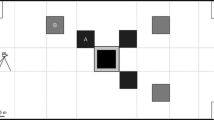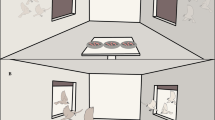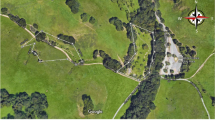Summary
To investigate the dynamics of the winter flock patch exploitation, feeding experiments were performed with 140 semi-tame, free-roaming greylag geese (Anser anser). Three different initial densities of barley were offered on a 50-m2 patch: low (1600 grains/m2), intermediate (3300/m2) and high (I 1500/m2). Goose numbers on the patch, peck rates, and frequencies of agonistic encounters and of alert postures were observed by scanning the flock and in focal individuals. At low and intermediate initial food densities, peck rates decreased with food density, whereas at high food density, peck rates decreased only slightly over the feeding bout. Agonistic interactions increased as food decreased. A switch from exploitation to interference competition occurred at a threshold of approximately 900 remaining grains per square meter. With high initial food density, agonistic encounters began to increase gradually after 20–30 min. The same general patterns were observed for frequency of alertness. Family members occupied the patch for the longest time periods. The family female and the offspring fed most intensely. The family gander however, fed significantly less but was more aggressive and vigilant than all other social categories. Solitary geese spent their time on the patch doing little else but feeding and were the first to leave. It seems that high-ranking families and low-ranking singles adopt different competitive strategies, the former being superior interference competitors whereas the latter are forced scramble competitors.
Similar content being viewed by others
References
Abrahams MV, Dill LM (1989) A determination of energetic equivalence of the risk of predation. Ecology 70:999–1007
Ankney CD (1984) Nutrient reserve dynamics of breeding and molting brent. Auk 101: 361–370
Black JM, Owen M (1984) Importance of the family unit to barnacle goose offspring - a progress report. Nor Polarinst Skr 181:79–85
Black JM, Owen M (1987) Determinants of social rank in goose flocks: acquisition of social rank in young geese. Behaviour 102:129–146
Black JM, Owen M (1988) Variations in pair bond and agonistic behaviors in barnacle geese on the wintering grounds. In: Weller M (ed) Waterfowl in winter. University of Minnesota Press, Minneapolis, pp 39–57
Black JM, Owen M (1989a) Parent-offspring relationships in wintering barnacle geese. Anim Behav 37:187–198
Black JM, Owen M (1989b) Agonistic behavior in barnacle goose flocks - assessment, investment and reproductive success. Anim Behav 37:199–209
Black JM, Carbone C, Wells RL, Owen M (in press) Foraging dynamics of goose flocks: the costs of living on the edge. Anim Behav
Caro TM (1986) The functions of stotting: a review of hypotheses. Anim Behav 34:663–684
Dick G (1988) Feeding behaviour of the greylag goose (Anser anser): a field study. Ökol Vogel 10: 59–69
Dittami JP (1981) Seasonal changes in behavior and plasma titers of various hormones in barheaded geese, Anser indicus. Z Tierpsychol 55:289–324
Drent R (1980) Goose flocks and food exploitation: how to have your cake and eat it. Proc Int Ornithol Congr 17:800–806
Drent R, Swierstra P (1977) Goose flocks and food finding: field experiments with barnacle geese in winter. Wildfowl 28:15–20
Drent R, Ebbinge B, Weijand B (1979) Balancing the energy budgets of arctic-breeding geese through the annual cycle: a progress report. Verh Ornithol Ges Bayern 23:239–264
Goss-Custard JD (1970) Feeding dispersion in some overwintering wading birds. In: Crook JH (ed) Social behaviour in birds and mammals. Academic Press, London, pp 3–34
Hausberger M, Black JM (1990) Do females turn males on and off in barnacle goose social display? Ethology 84:232–238
Inglis IR, Lazarus I (1981) Vigilance and flock size in brent geese: the edge effect. Z Tierpsychol 57:193–200
Krebs JR, Davies NB (1987) An introduction to behavioural ecology. Blackwell Scientific, Oxford London
Krebs JR, Kacelnik A (1991) Decision-making. In: Krebs JR, Davies NB (eds) Behavioural ecology. Blackwell, London, pp 105–136
Kuyken E (1969) Grazing of wild geese on grasslands at Damme, Belgium. Wildfowl 20:47–54
Lamprecht J (1986a) Structure and causation of the dominance hierarchy in a flock of bar-headed geese (Anser indicus). Behaviour 96:28–48
Lamprecht J (1986b) Social dominance and reproductive success in a goose flock (Anser indicus). Behaviour 97:50–65
Lamprecht J (1989) Mate guarding in geese: awaiting female receptivity, protection of paternity or support of female feeding. In: Rasa AE, Vogel C, Voland E (eds) The sociobiology of sexual and reproductive strategies. Chapman and Hall, London New York, pp 48–60
Lazarus J (1978) Vigilance, flock size and domain of danger size in the white-fronted goose. Wildfowl 29:135–145
Lazarus J, Inglis IR (1978) The breeding behaviour of the pinkfooted goose: parental care and vigilant behavior during the fladging period. Behaviour 65:62–88
Lorenz K (1988) Hier bin ich-wo bist du? Ethologic der Graugans. Piper, München Zürich
Lorenz K, Kalas S, Kalas K (1978) Das Jahr der Graugans. R. Piper, München Zürich
Madsen J, Mortensen CE (1987) Habitat exploitation and interspecific competition of moulting geese in East Greenland. Ibis 129:25–44
Milinski M, Heller R (1978) Influence of a predator on the optimal foraging behaviour of sticklebacks (Gasterosteus aculeatus). Nature 275:642–644
Milinski M, Parker GA (1991) Competition for resources. In: Krebs JR, Davies NB (eds) Behavioural ecology. Blackwell, London, pp 137–168
Myers JP, Connors PG, Pitelka FA (1979) Territory size in wintering sanderlings: the effects of prey abundance and intruder density. Auk 96: 551–561
Owen M (1979) Food selection in geese. Verb Ornithol Ges Bayern 23:169–176
Patterson IJ (1977) Aggression and dominance in winter flocks of shel duck Tadorna tadorna (L.). Anim Behav 25:447–459
Pearson SM (1989) Food patches and foraging group size in granivorous birds. Anim Behav 38:665–674
Prop J, Eerden MR, Drent RH (1984) Reproductive success of the barnacle goose Branta leucopsis in relation to food exploitation on the breeding grounds, Western Spitsbergen. Nor Polarinst Skr 181:87–117
Raveling DG (1970) Dominance relationships and agonistic behaviour of Canada geese in winter. Behaviour 37:291–319
Schindler M, Lamprecht J (1987) Increase of parental effort with brood-size in a nidifugous bird. Auk 104:688–693
Schneider J, Lamprecht J (1990) The importance of biparental care in a precocial, monogramous bird, the bar-headed goose (Anser indicus). Behav Ecol Sociobiol 27: 415–419
Sedinger JS, Raveling DG (1984) Dietary selectivity in relation to availability and quantity of food for goslings of cackling geese. Auk 101:295–306
Sedinger JS, Raveling DG (1988) Foraging behavior of cackling canada goose goslings: implications for the role of food availability and processing rate. Oecologia 75:119–124
Sokal RR, Rohlf FJ (1981) Biometry. Freeman, New York
Sutherland WJ, Parker GA (1985) Distribution of unequal competitors. In: Sibly RM, Smith RH (eds) Behavioural ecology. Blackwell, London, pp 255–273
Teunissen W, Spaans B, Drent R (1985) Breeding success in relation to individual feeding opportunities during spring staging in the Wadden Sea. Ardea 73:109–119
Williams JE, Kendeigh SC (1982) Energetics of the canada goose. J Wildl Manage 46:588–600
Author information
Authors and Affiliations
Additional information
This study is dedicated to the memory of Konrad Lorenz
Correspondence to: K. Kotrschal
Rights and permissions
About this article
Cite this article
Kotrschal, K., Hemetsberger, J. & Dittami, J. Food exploitation by a winter flock of greylag geese: behavioral dynamics, competition and social status. Behav Ecol Sociobiol 33, 289–295 (1993). https://doi.org/10.1007/BF00172926
Received:
Accepted:
Issue Date:
DOI: https://doi.org/10.1007/BF00172926




